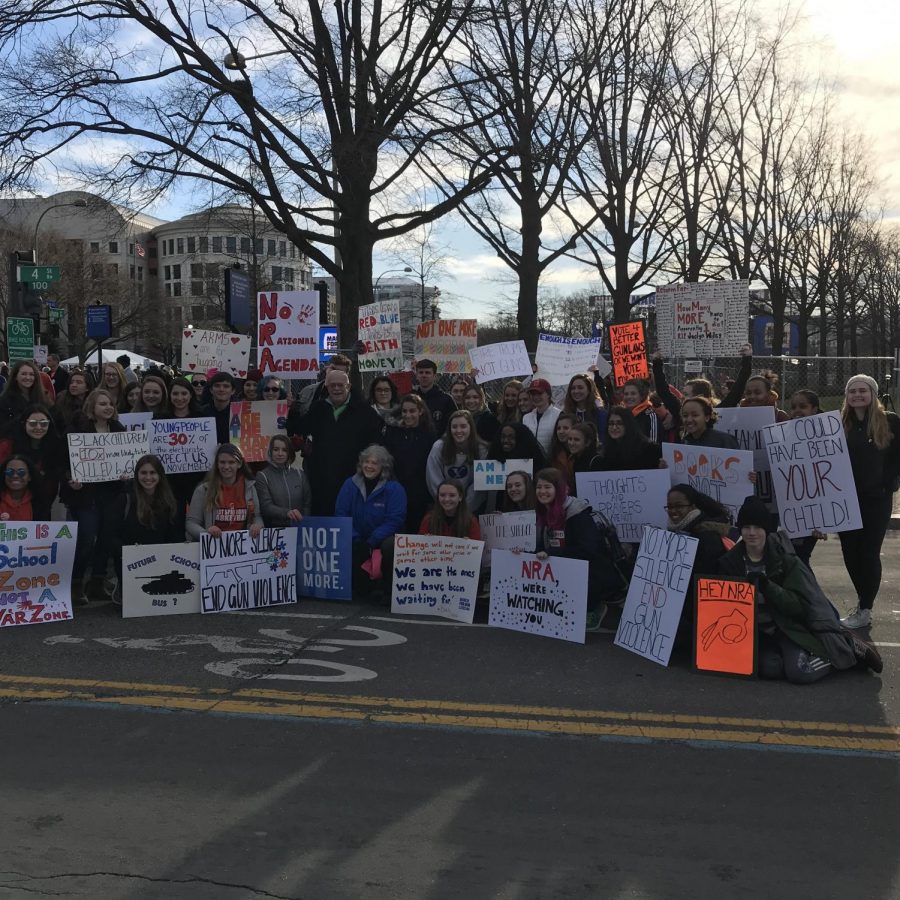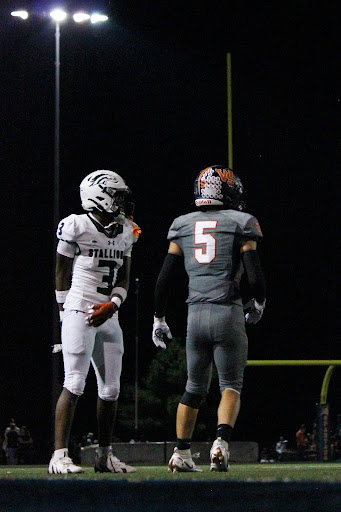Spartans participate in the March for Our Lives
WS students marched in Washington, DC on March 24th to advocate for gun control
Photo courtesy of John Heaton
WS students stand together at the March for Our Lives holding signs that express their discontent for the current gun laws in the country.
April 19, 2018
Junior Laura Kirk, standing in the crowd at the March for Our Lives on March 24th, was torn: Should she attempt to reach the Comedy Central show The Opposition that had asked to interview her? Or should she stay put for the benefit of the French documentary crew following her for the day?
Ultimately, Kirk decided to brave the hordes of people, but she returned in defeat roughly fifteen minutes later; the streets were just too crowded to travel far.
A few moments later, the documentary crew appeared behind her, struggling with a hefty camera. They, at least, were more than happy to stay in one place—they spent the following three-hour-long rally questioning Kirk about her activism on social media.
In other words, Kirk was being taken seriously–and no wonder. In the wake of the shooting at Marjory Stoneman Douglas High School, teenagers have emerged as leaders of the gun control movement, using social media and protest within and outside of school to bring change.
Kirk in particular has taken swift action, starting gun-control club Spartans Demand Action (SDA) with senior Ella Wogaman. The two were inspired to do so after meeting Jay Falk, a senior at TC Williams, at a Fairfax County School Board meeting in late February; the students had attended to encourage the school board to pass a resolution asking Virginia legislators to approve gun-control legislation. While the students’ efforts were successful, they wanted to do more.
“So me and a bunch of other students from across DC and Maryland and Virginia just met in Jay Falk’s basement…and were kind of like, ‘what can we do?’” said Kirk. The students decided to each return to their schools to start individual gun control groups to foster the movement on a local level.
“It really just took off from there,” said Wogaman. “We have about 150, 200 members now, we have running social media, that kind of thing. It’s pushing itself; there’s a lot of momentum from the students.”
That momentum was evident at the school walkout on March 14th, where Spartans streamed out of classrooms to gather and protest on the bleachers by the football field. Not only did SDA help organize the protest, but many of its members also took part, such as junior Sophia Haile.
“I participated in one [walk out], actually, during my math test, which was very risky. But my teacher said, ‘Just put something over your test and you can walk out,’” said Haile, “and it was a wonderful experience, and I can’t wait to tell my kids I didn’t sit back and do nothing.”
As Wogaman and Kirk’s influence spread throughout the school, adults began to take note. On the Friday before the march, they were invited to a round table discussion on gun violence prevention with Senator Tim Kaine; they were the only two students present among a host of gun violence activists and community leaders.
“It was really cool to be invited into the conversation. The students are the ones making the change, so it’s cool that we get to have input,” said Wogaman. “I mean, Senator Kaine was asking the people there for advice. He said, ‘This is what [the] state of legislation is: what do you want me to do? What should I put in effort in doing?’ And it was cool to actually be asked that as a student. As a seventeen-year old, I could actually have a direct effect on our legislation.”
The round table, however, was not the end to Kirk and Wogaman’s contribution.
Thirty-seven Spartans gathered at the Franconia-Springfield Metro Station at 7:30 on the morning of the March for Our Lives, clutching posters with slogans like “slay with puns, not guns” and “this is a school zone, not a war zone” and carrying bags stuffed with granola bars to sustain them through hours ahead. The group was composed of SDA members and their friends and siblings, all of whom had gathered to march into the capital together–under the leadership of Wogaman and Kirk.
Before finding a spot at the rally, the group first met up with branches of Students Demand Action from other schools, as well as local representatives like Delegate Eileen Filler-Corn and Congressman Gerry Connolly. The politicians gave short speeches praising the students’ activism but also imploring them to sustain their political involvement–and to vote. Both were optimistic about the power of youth to make change.
“We just saw how powerful the moral voice of young people can be at…Parkland. Those kids got organized. They had a televised town hall meeting; they forced politicians to defend themselves or explain themselves. They actually helped change votes in the Florida General Assembly and helped force the Republican governor, who had an A rating from the NRA, to sign into law some gun control measures for the first time, in a state that may be the most reactionary when it comes to guns: Florida,” said Connolly. “So they’ve shown they can make a difference. And if we sustain that, and we vote in elections, we’re going to make a big difference in this country–we’re going to turn public opinion and turn the tide on guns.”
After signing a banner, the SDA members left the lawmakers to find spots; their early arrival earned them positions relatively close to the stage–prime position to see the news crews constantly weaving through the crowd. (One, consisting of videographer Alex Fisher Wagner, stopped and interviewed Kirk, having heard her name from another student activist.)
Students also had a clear view of a jumbotron, allowing them to watch the various speeches and performances once the rally portion of the march began. Junior Carmen Tran, the SDA secretary, was especially moved by the words of Parkland survivor Cameron Kasky, but her favorite part of the experience was merely standing in the crowd.
“It was really empowering to see all these people together [who] believe the same thing, [who] believe in a better future for all of us as a whole—not just our students, but as a whole community,” said Tran. “Chicago communities, Brooklyn communities, all of us together [are] fighting for the same thing—fighting for our lives.”
For SDA, that fight has not ended. Kirk and Wogaman have already begun to plan their next steps.
“We’re planning another walkout on April 20th, and possibly a letter delivery to Congress where we write our legislators and deliver [the letters]…and in the future we hope to do things like voter registration and letter writing drives and setting up meetings with legislators,” said Kirk.
Despite the gravity of the issue they are fighting for, Kirk and Wogaman have found a silver lining to their struggle: their activism has begun to widen their horizons.
“Before this whole ordeal, I thought of our legislators as so far away, very much at a distance. I was like, ‘Oh, I’m never going to talk to them, not my senators,’” said Wogaman, “but now it’s like, ‘Oh, they’re people, too.’ I can email Gerry Connolly’s office and get him at a meeting. Like, I can do that. I can make that happen. And that’s just a cool idea, and it makes me feel like change is very possible.”
Connolly himself was appreciative of the strength of teenagers like Wogaman.
“Young people are not going to sit on the sidelines,” he said. “They’re going to get involved. And that’s power.”
In Wogaman’s case, however, the power to fight for gun control feels like a responsibility.
“Obviously, if the adults aren’t going to do it, we’ve got to step it up,” she said.





